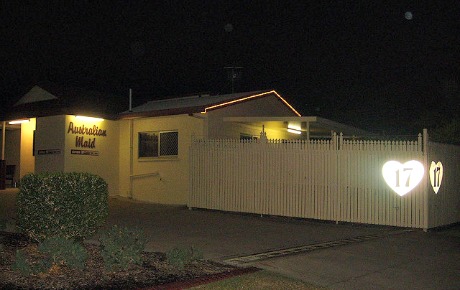
Bild: robstephaustralia
"Legalised prostitution – a failed experiment"
2013-02-17 | Mary Lucille Sullivan

OPINION/INTERNATIONAL
Should Sweden learn from Australia? In January, Feministiskt Perspektiv published an article where Tara Naja Lykke from Scarlet Alliance was critical towards the Swedish ban on buying sex and stated that there are benefits with the Australian legislation. In a response Mary Sullivan describes the deficiencies in those policies and notes that Scarlet Alliance requires members to share the interests of the sex industry.
Pro-prostitution advocates promote decriminalisation of prostitution as the solution to the massive and largely unregulated expansion of a worldwide prostitution trade where women remain vulnerable to sexual abuse and exploitation. They go further and suggest indeed that the ‘right to work’ in prostitution is a human right fundamental to one’s individual autonomy. Pro-prostitution campaigners dismiss any debate on the issue as moralistic. Through this labeling, they attempt to silence those feminists and social justice activists who understand the prostitution industry as violent and discriminatory, and prostitution as an extreme form of violence. They also dismiss the many voices of prostituted women and survivors of prostitution whose experience rules out any notion that prostitution should be regarded as ‘legitimate work’.
The pro-prostitution lobby frequently cites Australia as an example of the success of the decriminalisation model. Policy regimes across the various Australian states and territories range from a highly regulated licensing approach that exists in the State of Victoria to a decriminalised approach that operates in the State of New South Wales. Here the only restrictions are that brothels must comply with local planning laws and street prostitution must occur in zoned areas. All told, across Australia, the law regards prostitution as legitimate work and brothel owners as business operators; and places minimal restrictions on their promoting prostitution as a professional, profitable business enterprise.i
The Scarlet Alliance presents itself as the peak ‘sex worker’ association in Australia and is a major defender of the pro-prostitution position. Indeed the Association’s membership requires that those who join must agree to its objectives. Members must acknowledge that ‘sex work is a legitimate occupation’. Moreover they must be ‘actively promoting the right to work... including street, brothel, and escort, private and opportunistic work’.ii The Scarlet Alliance undisputedly opposes ‘the development of exit strategies and programs for women who wish to leave the sex industry, particularly trafficked women’.iii
Scarlet Alliance’s platform parallels sex business interests and buyers in its push to have prostitution part of the mainstream economy. It is also in line with Australian governments’ legislative prostitution regimes through which governments benefit through licensing, taxation and prostitution tourism. Perhaps not surprisingly, since 2004, the Scarlet Alliance has received ongoing government funding.iv A spotlight on the Australian experience, however, demonstrates that legitimising prostitution as work exacerbates the harms of prostitution, and produces further harms of its own making.
Project Respect, a non-profit, feminist community-based organisation provides specialist support to women in the sex industry, including women trafficked to Australia. They support the Swedish anti-violence prostitution legislation and recognise the dangers of regarding prostitution as legitimate work. Women at all levels at Project Respect, many of whom have been in the sex industry, work collaboratively to address barriers and structural inequalities for individual women every single day. Further, they work to eradicate the reasons why women need the organisation’s support. Project Respect’s Outreach Coordinator, Shirley Woods, says that based on her nine years of doing outreach work, women who find it empowering or a positive experience are in the minority.v As Project Respect’s Director Kelly Hinton, explains ‘we speak from our experience as an outreach report service, these are the things they see, these are the things that women report to us, and this is our experience’. vi
The expansion and normalisation of prostitution that resulted from Australia’s legitimising the sex industry provided the major justification for the mobilisation of a female ‘workforce’ to supply the trade.vii Under Australian law, prostitution is considered a consensual act between parties where the prostituted woman ‘consents’ to be used sexually by the male buyer. This legal interpretation takes for granted that the social conditions under which men participate in the prostitution transaction are the same as those for women. Legalisation and decriminalisation do not alter the reality that gender inequality in the form of economic vulnerability, which extends to homelessness, remains the prime reason why women ‘choose’ and remain in prostitution.
Project Respect’s outreach work involves many women who have limited life choices when entering prostitution, a reality that does not change because prostitution is called work. Shirley Woods has observed increasing numbers of African women, women from Asian countries, as well as Indian women entering the industry. These women report experiencing difficulty entering the mainstream workforce through lack of skills, little education in their home country, language barriers and racism. Of the women Woods reaches in her outwork programs, she also estimates around 75 per cent are single mothers. Many belonging to this group enter prostitution to earn money to escape domestic violence situations in the home. Seventy-two per cent of the women encountered in the last year have been in housing stress. As well, Woods sees growing numbers of women with bipolar disorders. Another characteristic of those in the industry is the high number of older women who have trouble exiting the industry because of lack of self-esteem that they can do anything else and no career training.viii These are the experiences, constraints and limited options for economic independence or survival which influence many women’s entry into prostitution.
Various state and territory studies support Project Respect’s experience on why women enter and remain in prostitution in Australia. They have highlighted economic and social vulnerability as the most common motivations. A recent Consumer Affairs of Victoria (CAV) report into the Victorian brothel sector, for example, concluded that the major driver for women to enter and remain in prostitution is ‘financial need’.ix Prostitution was found to be ‘particularly attractive to mothers raising children alone, to students and other workers whose opportunities for work were limited by lack of skills or training/and or language barriers. Older workers reported facing struggles to maintain earnings’.x Research has also found that young indigenous women are particularly vulnerable to prostitution.xi Supporting international evidence, Australian research also documents a high prevalence of sexual violence in childhood and adulthood amongst women in prostitution and identifies this as a pathway into the sex industry.xii
Australia’s decriminalised/legalised regimes fail equally to support and safeguard women because most prostitution continues to operate illegally, dispelling the myth that women can now ‘work’ in a well regulated and safe prostitution environment. Indications are that illegal prostitution is significantly larger than the regulated sector. Highlighting the problem in the State of Queensland, the State’s Crime and Misconduct Commission prostitution law review confirmed that ‘only about 10 per cent of all prostitution services available in Queensland [where brothel prostitution is legal] are currently operating within the legal brothel system’.xiii There was also evidence that illegal prostitution activities had ‘continued unabated since the implementation of the Prostitution Act, despite the increase in policing activities’.xiv Similar findings have been found for other states and territories.xv
It is also a fiction that a neat distinction can be made between the legal and illegal sectors. Evidence of significant links between these sectors is provided in several major prostitution inquiries. Examples include the Queensland’s (2004) Crime and Misconduct Commission prostitution law review and more recently Consumer Affairs Victoria 2009 inquiry into brothels.xvi Currently New South Wales is examining reworking its decriminalised prostitution regime. The Government’s objectives include to clamp down on the use of brothels by organised crime groups and to ensure legal brothels comply with the law; this is in addition to closing illegal brothels.xvii In this erratic environment, women move between licensed and unlicensed brothels and/or street/escort prostitution. In the Victorian instance, it is estimated that around 50 per cent of prostituted women have worked in at least three sectors, including legal and illegal.xviii
For the few women who do work in a legal context, occupational health and safety (OHS) standards are seriously inadequatexix. Australia’s OHS strategies for prostitution businesses are unambiguously focused on containing the spread of sexually transmitted infections (STIs), particularly in brothels. Compulsory testing for prostituted women is implied under most Australian prostitution legislation. By ignoring the male buyer, governments not only discriminate against women, but also help create the perception that they are the purveyors of disease.
All women have the right to have access to prophylactics to protect their reproductive health. OHS for prostitution businesses makes provision for this. In practice, however, the implementation by brothel owners of OHS guidelines is inconsistent and health inspections in brothels are irregular. More critical still is that the provision of condoms to women made vulnerable to sexual exploitation through poverty, racism and gender disparity does not work to protect their health. Shirley Woods makes this point. She has found that ‘there has always been a demand from clients for oral sex without condoms…this demand is increasing despite education about HIV as is anal sex’. The problem is aggravated because of the normalisation of pornography in brothels. While brothels are required by law to have a sign regarding safe sex they will also having running ‘anal porn, group porn and porn without condoms’ says Woods. With increasing competition, older women have difficulties getting bookings and language barriers which make negotiation with a buyer impossible, such demands are frequently met.xx
The most significant failure of Australia’s OHS for women in prostitution it that is assumes that women are always able to negotiate safe sex, despite the power imbalance inherent in the prostitution transaction. This power inequity between a prostituted woman and the buyer is starkly evident in the risk prevention strategies prostituted women require to simply survive where violence is recognised as ‘an inherent risk of the job’. These include panic buttons, video surveillance to screen clients and, when these fail, self-defense courses and expertise in negotiation skills and hostage skills. This places the emphasis more and more on the individual, necessary because no OHS strategies can create a safe and healthy work environment when everyday prostitution ‘work practices’ and the prostitution ‘work environment’ are innately harmful.
The harm inherent in prostitution ‘work’ practices and the prostitution ‘work’ environment is perhaps best illustrated by the fact that OHS guidelines list STIs, unwanted pregnancies, sexual harassment, physical violence, abuse and rape as specific health risks whether prostitution is legal or illegal.
Sex trafficking has also not disappeared under Australia’s ‘model’ prostitution laws and granting women working visas to work in the industry will not solve this alarming practice. Establishing the scale of trafficking is extremely difficult, and available statistics often take no account of women and girls who are trafficked domestically, that is between states and territories, as this is largely undetected. Project Respect estimates that about 2000 people per year are trafficked although they believe that realistically the number is much higher.xxi Victoria’s Drugs and Crimes Convention Committee in its (2010) inquiry into sex trafficking also noted concerns ‘that the illicit trade in women for sexual purposes is increasing’.xxii
There are serious limitations of approaches to tackle trafficking that focus only on the ‘means of delivery’ rather than into the sex industries into which they are delivered. One of the most crucial factors in understanding the link between prostitution and the importation of women from abroad is the existence of a legal market. The United States Trafficking in Persons (2004–10) reports has consistently identified Australia as a destination country for women and children trafficked for prostitution, with the numbers reported proportionate to population. Prostitution businesses where these women and girls are prostituted are generally the same operations as where Australian women are prostituted. The legal and social acceptance of prostitution in most states and territories makes Australia an attractive option for traffickers.
Another question is whether legalisation assists in the discovery or care of victims, or if it can hamper policing. The ongoing assumption by much of Australia’s law enforcement system is that criminal activity, including sex trafficking, is associated with the illegal brothel trade. However, there is evidence that there is a clear and close connection between sex trafficking and the legal prostitution sectors. This fact is highlighted in both the Commonwealth inquiry into sex trafficking (2003) and the more recent Victorian Drugs and Crime Prevention Report (2010).xxiii To date, all cases of trafficking that have been prosecuted have involved legal brothels. This is also the case with the trafficked women that Project Respect assists, where the cases do not come before the authorities.xxiv
A further problem in the discovery and care of victims is the restrictions on policing the legal sector. As a legal entity, brothels are mainly considered a planning issue and police have minimal rights to enter the premises. This difficulty is explained by Project Respect’s Kelly Hinton. ‘One of the issues for the police is that when they go into a brothel and they may meet a women who is trafficked…she is here legally, working within her rights….unless she actually says to the police this is not okay, this is what they have done to me…say they are there for 2 hours, unless she builds up the trust in 2 hours, …chances are they male, she has been told the police are corrupt, the police in her country are corrupt...there is nothing they can do...it is all based on the victim, on her being able to come forward and say this is what has happened to me’.xxv
Hinton sees serious limitations to the idea that ‘sex work visas’ would minimise the incidence and harms of sex trafficking. As she points out ‘firstly, most trafficked women are not illegal but are here legally and working legally’. (Many for example, have student visas). ‘Additionally most of the women we have met that are trafficked have come from countries where prostitution is illegal so how could they apply for a visa in their home country’. Hinton’s most significant argument, however, is that granting ‘“sex work visas” doesn’t take into account the deception and the reason they were trafficked’. Finally ‘how can you decide on something like a “sex work visa” when there is so much debate about whether that “work” is safe or not? It is based on the argument that “sex work” is fine and there a plenty of women in prostitution who think it is not’.xxvi
This continuing importation of women for prostitution including trafficking is perhaps one of the more overt demonstrations that violence and exploitation against women in prostitution has not been reduced under legalised/decriminalised systems.
i The exceptions are the States of Western Australia and South Australia where currently, while prostitution itself is not illegal, associated activities such as brothel keeping and soliciting are criminalised.
ii Scarlet Alliance. Objectives. Available at http://www.scarletalliance.org.au/object/ (Last Accessed 4 February 2013).
iii Scarlet Alliance. Response to Victorian Recommendations for Trafficking into Sex Work 2010. Available at http://www.scarletalliance.org.au/laws/vic/vicrecommendations_2010/ (Last Accessed 4 February 2013).
iv Scarlet Alliance. Scarlet Alliance History. Available at http://www.scarletalliance.org.au/who/history/ (Last Accessed 4 February 2013).
v Mary Sullivan. (2013). Interview with Kelly Hinton (Director) and Shirley Woods (Outreach Coordinator) Project Respect. (29 January) Melbourne.
vi Ibid.
vii For further discussion of this development see Mary Sullivan, (2007), Making Sex Work (Spinifex), chapter 4.
viii Ibid, Sullivan, Interview Project Respect.
ix (Pickering, S., Maher, J.M. and Gerard, A. (2009) Working in Victorian Brothels: An Independent Report Commissioned by Consumer Affairs Victoria into the Victorian Brothel Sector. Available at http://www.consumer.vic.gov.au/library/publications/resources-and-education/research/working-in-victorian-brothels-2009.pdf (Last Accessed 4 February 2013).
x Ibid, p.v
xi Holmes, C. and McRae-Williams, E. (2008) An Investigation into the Influx of Indigenous ‘Visitors’ to Darwin’s Long Grass from Remote NT Communities –Phase 2. National Drug Law Enforcement Research Fund. http://www.ndlerf.gov.au/pub/Monograph_33.pdf(Last Accessed 4 February 2013).
xii Crime and Misconduct Commission (2004) Regulating Prostitution: An Evaluation of the Prostitution Act 1999. Queensland: Crime and Misconduct Commission.
xiii Ibid, p.xii
xiv Ibid, p.80
xv See for example, Municipal Association of Victoria, ‘Councils Need More Support to Deal With Illegal Brothels’, Media Release 25 January (Melbourne 2007). Available at http://planning-enforcement.com/doc/MR_illegal_brothels.pdf (Last Accessed 4 February 2013).
xvi Ibid, Crime and Misconduct Commission; Pickering et al.
xvii Roth, L. (2011).Regulations of Brothels: an update E-Brief (15 February). New South Wales Parliamentary Research Library Service. Available at http://www.parliament.nsw.gov.au/prod/parlment/publications.nsf/key/Regulationofbrothels:anupdate/$File/E-brief.regulation+of+brothels.pdf (Last Accessed 4 February 2013).
xviii Ibid, Pickering et al., p.v
xix The application of OHS for the prostitution industry is dealt with in depth in M. Sullivan (2007) Making Sex Work (Melbourne: Spinifex), chapters 8 and 9.
xx Ibid, Sullivan, Interview Project Respect.
xxi Ibid, Sullivan, Interview Project Respect.
xxii Drugs and Crimes Convention Committee (2010) Inquiry into People Trafficking for Sex Work: Final Report. Melbourne: Parliament of Victoria, p.3.
xxiii See Ibid., and Commonwealth of Australia (2003) Trafficking in Women for Sexual Servitude. Joint Committee on the Australian Crime Commission, 18 November 2003. Melbourne.
xxiv Ibid, Sullivan, Interview Project Respect.
xxv Ibid, Sullivan, Interview Project Respect.
xxvi Ibid, Sullivan, Interview Project Respect.
Kommentarer
Du måste vara inloggad för att kunna lämna en kommentar.
























MEST KOMMENTERAT
SENASTE KOMMENTARERNA
Om Var Grupp 8 en feministisk organisation?
Om #bildskolan 21: Att äta Den Andre
Om #bildskolan 21: Att äta Den Andre
Om Porr handlar om betalda övergrepp
Om Nobels fredspris till kampanj för att avskaffa kärnvapen
Om Feministiskt perspektiv öppnar arkivet och startar på nytt!
Om Rödgrönt ointresse för fred och nedrustning borde oroa många
Om Var inte målet att vi skulle jobba mindre?
Om Feministiskt perspektiv öppnar arkivet och startar på nytt!
Om Feministiskt perspektiv öppnar arkivet och startar på nytt!
MEST LÄST